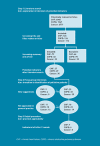Early identification of palliative care patients in general practice: development of RADboud indicators for PAlliative Care Needs (RADPAC)
- PMID: 22947583
- PMCID: PMC3426601
- DOI: 10.3399/bjgp12X654597
Early identification of palliative care patients in general practice: development of RADboud indicators for PAlliative Care Needs (RADPAC)
Abstract
Background: According to the World Health Organization (WHO) definition, palliative care should be initiated in an early phase and not be restricted to terminal care. In the literature, no validated tools predicting the optimal timing for initiating palliative care have been determined.
Aim: The aim of this study was to systematically develop a tool for GPs with which they can identify patients with congestive heart failure (CHF), chronic obstructive pulmonary disease (COPD), and cancer respectively, who could benefit from proactive palliative care.
Design: A three-step procedure, including a literature review, focus group interviews with input from the multidisciplinary field of palliative healthcare professionals, and a modified Rand Delphi process with GPs.
Method: The three-step procedure was used to develop sets of indicators for the early identification of CHF, COPD, and cancer patients who could benefit from palliative care.
Results: Three comprehensive sets of indicators were developed to support GPs in identifying patients with CHF, COPD, and cancer in need of palliative care. For CHF, seven indicators were found: for example, frequent hospital admissions. For COPD, six indicators were found: such as, Karnofsky score ≤50%. For cancer, eight indicators were found: for example, worse prognosis of the primary tumour.
Conclusion: The RADboud indicators for PAlliative Care Needs (RADPAC) is the first tool developed from a combination of scientific evidence and practice experience that can help GPs in the identification of patients with CHF, COPD, or cancer, in need of palliative care. Applying the RADPAC facilitates the start of proactive palliative care and aims to improve the quality of palliative care in general practice.
Figures
Similar articles
-
RADPAC-PD: A tool to support healthcare professionals in timely identifying palliative care needs of people with Parkinson's disease.PLoS One. 2020 Apr 21;15(4):e0230611. doi: 10.1371/journal.pone.0230611. eCollection 2020. PLoS One. 2020. PMID: 32315302 Free PMC article.
-
Timely identification of palliative patients and anticipatory care planning by GPs: practical application of tools and a training programme.BMC Palliat Care. 2016 Apr 5;15:39. doi: 10.1186/s12904-016-0112-9. BMC Palliat Care. 2016. PMID: 27044254 Free PMC article.
-
Early identification of and proactive palliative care for patients in general practice, incentive and methods of a randomized controlled trial.BMC Fam Pract. 2011 Nov 3;12:123. doi: 10.1186/1471-2296-12-123. BMC Fam Pract. 2011. PMID: 22050863 Free PMC article. Clinical Trial.
-
Developing indicators of appropriate and inappropriate end-of-life care in people with Alzheimer's disease, cancer or chronic obstructive pulmonary disease for population-level administrative databases: A RAND/UCLA appropriateness study.Palliat Med. 2017 Dec;31(10):932-945. doi: 10.1177/0269216317705099. Epub 2017 Apr 21. Palliat Med. 2017. PMID: 28429629 Review.
-
Palliative care programmes for people with conditions other than cancer in Thailand: a literature review.Int J Palliat Nurs. 2023 Aug 2;29(8):374-384. doi: 10.12968/ijpn.2023.29.8.374. Int J Palliat Nurs. 2023. PMID: 37620144 Review.
Cited by
-
A refined ICD-10 diagnoses-based approach for retrospective analysis of potential palliative care need and coverage in claims data of deceased.SAGE Open Med. 2024 Aug 13;12:20503121241269599. doi: 10.1177/20503121241269599. eCollection 2024. SAGE Open Med. 2024. PMID: 39144525 Free PMC article.
-
Palliative care for patients with heart failure: facilitators and barriers - a cross sectional survey of German health care professionals.BMC Health Serv Res. 2016 Aug 8;16(a):361. doi: 10.1186/s12913-016-1609-x. BMC Health Serv Res. 2016. PMID: 27503510 Free PMC article.
-
Application of palliative care in demented patients: the caregivers' point of view.Acta Biomed. 2018 Dec 7;89(7-S):78-88. doi: 10.23750/abm.v89i7-S.7895. Acta Biomed. 2018. PMID: 30539933 Free PMC article.
-
Predicting life expectancy with a long short-term memory recurrent neural network using electronic medical records.BMC Med Inform Decis Mak. 2019 Feb 28;19(1):36. doi: 10.1186/s12911-019-0775-2. BMC Med Inform Decis Mak. 2019. PMID: 30819172 Free PMC article.
-
Case conferences between general practitioners and specialist teams to plan end of life care of people with end stage heart failure and lung disease: an exploratory pilot study.BMC Palliat Care. 2014 May 5;13:24. doi: 10.1186/1472-684X-13-24. eCollection 2014. BMC Palliat Care. 2014. PMID: 24829539 Free PMC article.
References
-
- Franks PJ, Salisbury C, Bosanquet N, et al. The level of need for palliative care: a systematic review of the literature. Palliat Med. 2000;14(2):93–104. - PubMed
-
- Gomes B, Higginson IJ. Where people die (1974–2030): past trends, future projections and implications for care. Palliat Med. 2008;22(1):33–41. - PubMed
-
- McGrath P. Care of the haematology patient and their family — the GP viewpoint. Aust Fam Physician. 2007;36(9):779–781. 784. - PubMed
Publication types
MeSH terms
LinkOut - more resources
Full Text Sources
Medical


